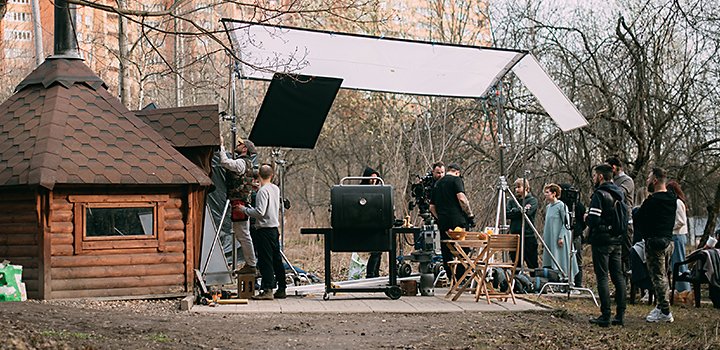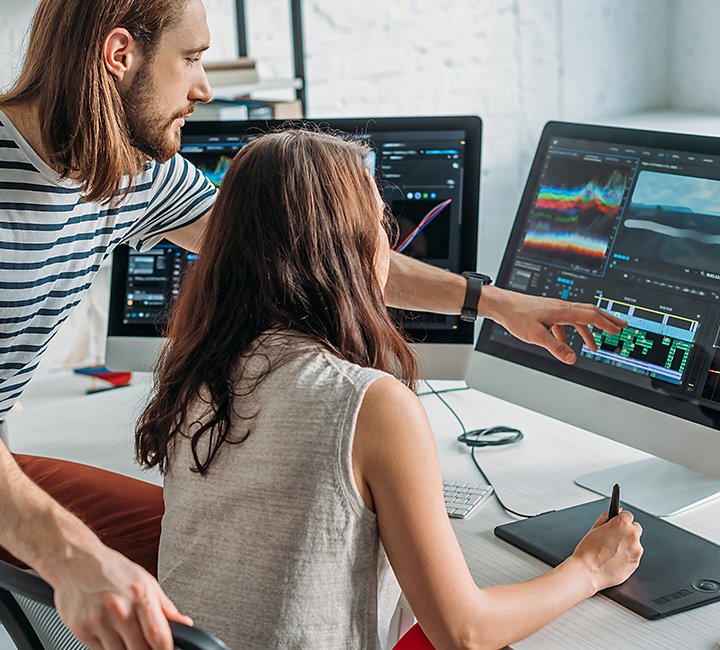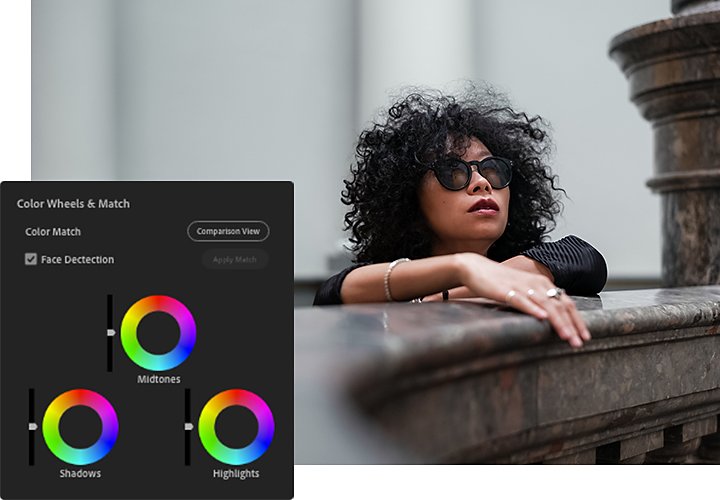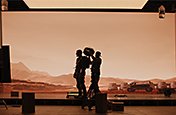Assemble and refine footage with post-production.
Go inside the filmmaking process and explore how to combine and polish scenes for the big screen. Get expert tips on editing basics from assembly to final cut.

What happens once filming is over?
Many people never consider how long it takes filmmakers to film a film and how long it takes editors to put it all together in post-production. But you’d never see a flick in the theatre without the editing, audio production and colour correction that happens after principal photography.
Post-production takes all the many and varied elements created during film production and transfers image and sound files into computer files to work within an editing workspace. During this process, it’s your job as an editor to synchronise files with your video, visual effects, live effects and everything else available from the production itself to create the entire film.
“In the course of my career, it can take from a month to a year or more, depending upon the project and the nature of the work,” says film director Jay Holben. Of course, depending on the type of film, the timing of how long it takes you to get through all the edits may vary, but these are the typical steps involved in the process of editing and finalising your project.
Inside the workflow.
Prior to any editing and post work, video production starts with the pre-production phase. This involves everything from financing to planning to hiring and every task in between to fill in a crew, find a location and workshop a script. After this stage is complete, your production has a plan. Next comes principal photography, known as the production phase. This is when you shoot your footage on location — at various different places, on a soundstage or both.

Once shooting is a wrap, it’s time for post-production — a highly collaborative process that involves several team members like sound editors, Foley artists, colorists and more. You’ll also have visual effects team members who produce additional visuals using a green screen and computers to generate the effects in a programme like Adobe After Effects. In addition, you’ll have sound recordings of actors’ dialogue, music from a composer, sound effects and audio mixing the entirety of the film.
How different filmmaking roles are involved in post-production:
- Filmmaker/Director/Producer: Transfers all footage to reliable storage.
- Editor: Edits pictures and raw footage.
- Cinematographer: Ensures the colour and feel of all shots is true to the style of the film.
- Sound mixer, sound designer, sound editor and Foley artist: Responsible for all sound from dialogue to sound effects.
- Composer/Music supervisor: Scores or secures the music.
- VFX supervisor/engineer: Creates visual effects.
- Colorist: Colour corrects files.
- Editor: Adds titles, credits and graphics.
You can also use any post-production steps and techniques that apply to traditional filmmaking in a promotional marketing video. The main difference between the advertising and film industry workflows is that the editor in advertising wears more hats due to budget, often directing, filming and editing.
Behind the editing process.
Beyond the techniques, editing can be a very involved process because you’re working with so much content. There are so many choices to make. However, modern cameras and their ability to organise digital footage files make some parts of editing easier, while other parts have become more challenging.
“We used to be very careful when shooting film because it was so expensive,” says director and screenwriter Steven Bernstein. “We would carefully plan each shot, limit the number of takes and mark them with a clapperboard using chalk or markers. But with digital cameras, we now use electronic slates and still label the shots. But the tendency is to just let the cameras run, because digital is cheap compared to film. This means the editor ends up with hundreds or thousands of hours of material.”
After you have all the footage, your job as an editor is to sift through selects and every other clip to seek out gems that show character, complexity and other key elements that enhance the overall storytelling. As soon as you have a good sense of the material you plan to use from the pile of raw footage, you can begin the editing process.
A crew will capture many different types of shots in principal photography. Often, films start with a wide shot, which shows the location of the entire scene. A wide shot can also have the action to hook the audience, so they understand an aspect of the main character. Medium shots, which typically show a character from the waist up, are where the audience experiences the character’s expressions and how they interact with other characters. Finally, close-ups zoom in to act as a focus on acting and emotion.
“In a wide shot, you don’t feel much for a character,” says Bernstein. “But when you go in very close, I mean right in there and a little tear runs down a cheek or you see just a movement of an eyebrow or a little bit of sadness or fear in the corner of the mouth — you’ve cranked up the emotional amplification.” Typically, in this initial part of the editing process, the editors decide when to use wide, medium or close-up shots.
Start the assembly.
The next step for an editor is typically working alone on the first pass of the film, called a rough cut. This part of the process is known as the assembly, where the editor roughly assembles all of the raw footage. At this point, the film runs too long, the shots are not precise and the pacing is loose — but everything is in the correct order. This is when the director comes in to review your editing work.

The director suggests what is effective, what isn’t and brings in any great moments and additional ideas they have in mind. Then, the editor reedits the film over and over. Usually, this process can take you up to 10 weeks or more for a feature film.
Finally, the assembly goes to fine cut — which has everything correctly timed and each scene works precisely. When the edit is complete, you’ll have an Edit Decision List (EDL). This means you’re editing a copy of the original material — a low-resolution copy that takes up less space on the computer.
“The EDL is then plugged into the computer, goes back to your original large high-resolution files you shot on set and replicates your edit on a timeline,” says Bernstein. “And now you have the high-quality stuff that then goes to a lab, studio or effects place.”
For films that need visual effects (VFX) or computer-generated imagery (CGI), like those created in After Effects, the VFX team adds them once the editing is complete. Since visual effects can be costly, a production ensures that they are finalising only the renders on special effects for scenes and moments that will make the film’s final cut.
After the edits are complete, the colorisation of the film — otherwise known as colour correction or colour timing — can begin.
The cinematographer comes in to see the cut of the film projected on a big screen and uses a variety of mechanisms and devices to colour time or colour correct the images. For example, colour timing allows you to make the images darker or lighter, change the colour balance, shade things out and change the frame’s size.

The director then looks at the colour time work that the cinematographer did with the technician. This process happens at the same time sound editing occurs.
When the director is satisfied with the cinematographer’s colour grading work, the film goes into sound mixing, where the original recorded sound is added with various other sound styles to complement it.
Sound mixing or editing, takes place when film editing is being finalised. This is when Foley artists come in to recreate sounds or actors come in to rerecord scenes. After removing any unwanted noise, the sound mixer adds background noise, voiceover, music or sound effects. Then it goes to the sound designer who combines the music, dialogue and Foley effects together to create audio tracks that go into the mix.
It can take up to three weeks to complete sound design. But usually, this doesn’t happen until the edit is done. “Everything funnels back to the editor, because the editor is going to hit the final export and send it,” says video editor Cody Liesinger. “It's up to that editor in post-production to explore the web that’s created and bring everything to the centre — whether it’s motion design, retouching, sound mixing, colour grading or music.”
That’s a wrap.
Once you’ve put the finished sound design into the mix and combined it with the colour-corrected image the cinematographers produced, you add the titles and the film is ready for the big screen.
Now that you understand how post-production works, you can start editing your own videos, short films or documentaries in a video editing software like Adobe Premiere Pro. And if you’re looking for some inspiration, go back and rewatch your favourite films — there’s always more to discover when it comes to filming and editing.
Contributors
Do more with Adobe Premiere Pro.
Make visually stunning videos virtually anywhere — for film, TV and web.
You might also be interested in…
Get an overview of the filmmaking process with these tips from professional filmmakers.
Heighten the artistry, efficiency and emotional depth of your work with these useful techniques.
Discover the process of making a video or film, from first draught to final cut.
How to make a documentary film.
Learn how to turn real-life stories into great nonfiction films.
Get Adobe Premiere Pro
Create flawless productions with the industry-leading video editing software.
7 days free, then HK$183.00/mo.



